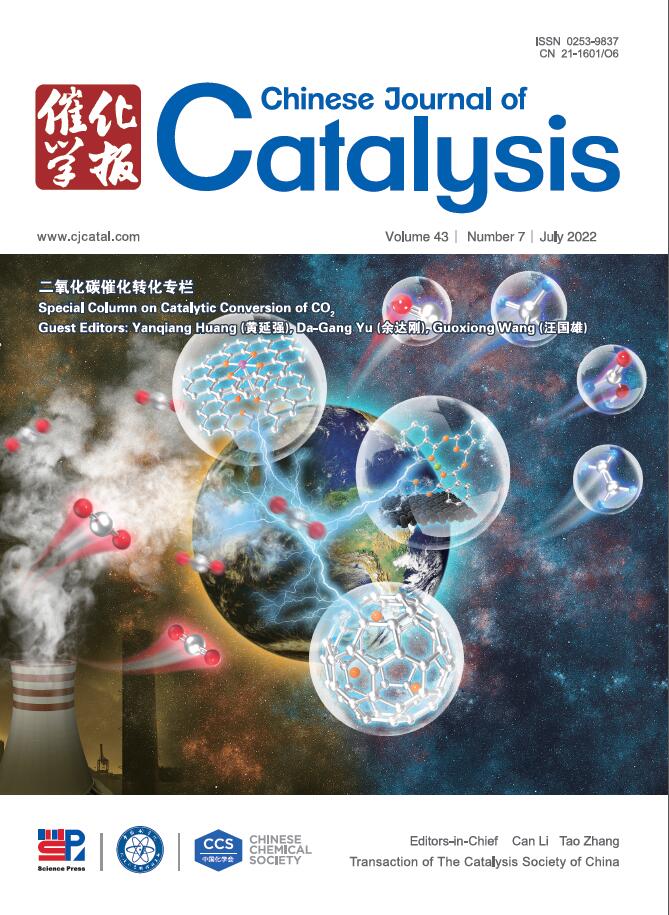光催化CO2还原中的一维纳米结构
IF 15.7
1区 化学
Q1 CHEMISTRY, APPLIED
引用次数: 0
摘要
大气污染和全球变暖引起了人们对CO2转化研究的极大兴趣,因为CO2是最重要的温室气体。光催化CO2还原反应(CRR)是一项关键的碳捕获与利用(CCU)技术,旨在将CO2转化为有价值的产品,如燃料和化学品。然而,许多用于CRR的半导体光催化剂面临着光吸收低、载流子分离差、电子-空穴复合等问题,导致反应产率低。解决这些问题的一些重要方法包括减小纳米结构尺寸、修饰助催化剂、金属/非金属掺杂和异质结的构建。纳米棒、纳米管、纳米线和纳米纤维等一维纳米结构具有优异的光吸收能力、高的电子空穴分离效率、高的长径比和丰富的暴露表面活性位点,是CO2还原过程中重要的光催化剂。本研究在研究CO2还原机理的基础上,首先探讨了基于生长环境的一维纳米材料生长方法。研究了光催化CRR的一维纳米结构类型。综述了改进CRR中一维光催化剂的两种主要策略,即表面改性和异质结的构建。最后,报告提出了CRR面临的一些重要挑战及其未来应用的解决方案。本文章由计算机程序翻译,如有差异,请以英文原文为准。
1D-based nanostructures in photocatalytic CO2 reduction
Air pollution and global warming have aroused great interest in CO2 conversion research, as CO2 is the most important greenhouse gas. Photocatalytic CO2 reduction reaction (CRR) is a key carbon capture and utilization (CCU) technology aimed at transforming CO2 into valuable products like fuels and chemicals. However, many semiconductor photocatalysts used in CRR face challenges such as low optical absorption, poor charge carrier separation, and electron-hole recombination, leading to low reaction yields. Some important solutions to these issues include reducing nanostructure dimensions, cocatalyst decoration, as well as metal/nonmetal doping, and heterojunction construction. One-dimensional (1D) nanostructures like nanorods, nanotubes, nanowires, and nanofibers are prominent photocatalysts for CO2 reduction process due to their excellent light absorption capability, high electron-hole separation efficiency, high aspect ratio, and abundant exposed active surface sites. In this research, after studying CO2 reduction mechanism, we first discuss 1D nanomaterials growth methods based on the growing environment. Types of 1D nanostructures in photocatalytic CRR, have been also investigated. Two main strategies to improve 1D-based photocatalysts in CRR including surface modification and heterojunction construction are reviewed. Finally, the report presents some important challenges of the CRR and their solutions for future applications.
求助全文
通过发布文献求助,成功后即可免费获取论文全文。
去求助
来源期刊

Chinese Journal of Catalysis
工程技术-工程:化工
CiteScore
25.80
自引率
10.30%
发文量
235
审稿时长
1.2 months
期刊介绍:
The journal covers a broad scope, encompassing new trends in catalysis for applications in energy production, environmental protection, and the preparation of materials, petroleum chemicals, and fine chemicals. It explores the scientific foundation for preparing and activating catalysts of commercial interest, emphasizing representative models.The focus includes spectroscopic methods for structural characterization, especially in situ techniques, as well as new theoretical methods with practical impact in catalysis and catalytic reactions.The journal delves into the relationship between homogeneous and heterogeneous catalysis and includes theoretical studies on the structure and reactivity of catalysts.Additionally, contributions on photocatalysis, biocatalysis, surface science, and catalysis-related chemical kinetics are welcomed.
 求助内容:
求助内容: 应助结果提醒方式:
应助结果提醒方式:


